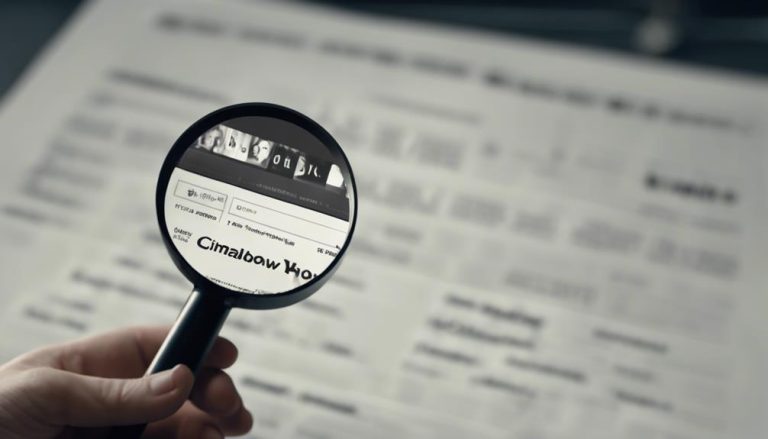SEO for Website Speed Optimization
As you work to improve your website's search engine ranking, you're likely aware of the importance of optimizing for keywords and content quality. But have you considered the impact of your website's speed on your SEO efforts? You might be surprised to learn that slow load times can actually hurt your ranking, as search engines like Google take page speed into account when determining placement. In fact, a slow website can lead to a higher bounce rate, damaging your credibility and trustworthiness in the eyes of search engines. So, what can you do to guarantee your website is loading quickly and efficiently?
Key Takeaways
- Slow-loading websites negatively impact search engine rankings, as search engines like Google consider page speed when determining rankings.
- Optimizing image file sizes through compression and minification can significantly improve website loading speed and user experience.
- Enabling compression and minification of website resources reduces file sizes, shrinking data transferred between the server and browsers.
- Minimizing HTTP requests through lazy loading, HTTP batching, and browser caching can reduce load time and improve responsiveness.
Understanding Page Speed Metrics
As you plunge into the world of website optimization, this is essential to grasp the various page speed metrics that measure your site's performance, including Page Load Time, First Contentful Paint, and Time to Interactive.
These speed metrics provide valuable insights into your website's user experience, helping you identify areas for improvement.
Page Load Time, the most straightforward metric, measures the time it takes for your entire webpage to load.
First Contentful Paint, on the other hand, tracks the time it takes for the first piece of content to appear on the screen, giving users an initial sense of progress.
Time to Interactive, a more nuanced metric, measures when your page becomes fully interactive, allowing users to engage with your content seamlessly.
Understanding these metrics is pivotal to optimizing your website's performance, as they directly impact user experience.
Impact of Slow Website on SEO
When you have a slow-loading website, you're likely to see a negative impact on your search engine rankings.
This is because search engines like Google take page speed into account when determining where to place your site in their results.
As you'll discover, slow load times can lead to a downward spiral in your search engine rankings, which can ultimately hurt your online visibility and credibility.
Slow Load Times
Slow load times can cripple your website's search engine ranking, with Google's algorithm demoting sites that take more than three seconds to load, thereby slashing your online visibility and potential revenue.
You're not just losing search engine favor; you're also driving away potential customers. User frustration sets in when they're forced to wait for your site to load.
According to studies, 40% of users will abandon a site that takes more than three seconds to load. This means you're losing conversion rates, as users aren't sticking around long enough to make a purchase or take a desired action.
Furthermore, slow load times will lead to a higher bounce rate, which can negatively impact your website's credibility and trustworthiness.
You've invested so much in creating a visually appealing and user-friendly website, but it's all for naught if it doesn't load quickly.
Optimizing your website's speed is vital to retaining users and maximizing conversion rates. By ensuring your site loads quickly, you'll keep users engaged, increase conversions, and ultimately, boost your online revenue.
Search Engine Rankings
Your website's search engine ranking takes a direct hit when load times creep above the three-second mark, with Google's algorithm penalizing sites that fail to meet this speed threshold. This penalty can be devastating to your online presence, as it directly affects your search engine trust and, subsequently, your user experience.
| Load Time | Impact on Search Engine Rankings |
|---|---|
| 1-2 seconds | Minimal impact, user experience is solid |
| 2-3 seconds | Slight penalty, user experience starts to suffer |
| 3-5 seconds | Noticeable penalty, user experience is compromised |
| 5-10 seconds | Significant penalty, search engine trust is lost |
| >10 seconds | Severe penalty, user experience is severely impacted |
As you can see, even a slight increase in load time can have a significant impact on your search engine rankings. This is because search engines prioritize user experience, and slow load times directly contradict this goal. By optimizing your website's speed, you can improve your search engine trust and, in turn, boost your online visibility. Don't let slow load times hold you back – take action to optimize your website's speed and reap the benefits of improved search engine rankings.
Optimizing Image File Sizes
By compressing image files, you can substantially reduce their file sizes, which in turn can improve your website's loading speed and overall user experience.
Image compression is a vital aspect of visual optimization, as it allows you to maintain the quality of your images while reducing their file size. This is achieved by removing unnecessary data from the image file, resulting in faster loading times.
There are various image compression algorithms available, including lossless and lossy compression. Lossless compression algorithms, such as PNG and GIF, preserve the image quality but result in larger file sizes.
On the other hand, lossy compression algorithms, such as JPEG, reduce the file size but compromise on image quality.
To optimize image file sizes, you can use tools like TinyPNG, ShortPixel, or ImageOptim, which utilize advanced compression algorithms to reduce file sizes without compromising on image quality.
Leveraging Browser Caching Techniques
Implement browser caching techniques to instruct browsers to store frequently-used resources locally, allowing them to load quickly from cache instead of re-downloading from your server on subsequent visits.
This technique reduces the number of HTTP requests made to your server, resulting in faster page loads and improved user experience.
To leverage browser caching, you'll need to configure your server to send cache headers with the HTTP responses.
These headers, such as Cache-Control and Expires, inform the browser how long it should store the cached resources.
Be mindful of browser limitations, as each browser has its own cache size limits and handling mechanisms.
For instance, Chrome has a cache size limit of around 315 MB, while Firefox has a more dynamic approach based on available disk space.
Enabling Compression and Minification
Having optimized browser caching, you can now further reduce the file size of your website's resources by enabling compression and minification, which shrink the data transferred between your server and visitors' browsers.
Compression reduces the file size by finding similar strings of code and replacing them with a reference to the original string. Gzip is a popular compression tool that can reduce file sizes by up to 70%, resulting in faster page loads and improved user experience.
The Gzip advantages are numerous, including reduced bandwidth usage, faster page loads, and improved search engine rankings.
To enable compression, you can use compression tools like Gzip or Brotli. These tools work by compressing files on your server, which are then sent to visitors' browsers in their compressed form.
Once received, the browser decompresses the files, allowing them to be rendered correctly. You can also enable minification, which removes unnecessary characters from your code, making it even smaller.
Optimizing Server and Database
You'll need to fine-tune your server and database configuration to guarantee they can handle the increased traffic and data transfer efficiently, as a slow server can negate all the optimization efforts made so far.
A slow Server Response can profoundly impact your website's loading speed, leading to high bounce rates and poor user experience.
To optimize your server, consider upgrading to a faster hosting plan, enabling caching, and configuring your server to use a content delivery network (CDN). This will reduce the time it takes for your server to respond to requests.
When it comes to your database, you'll want to optimize your Database Query to reduce the time it takes to retrieve data.
This can be done by indexing your database tables, optimizing your database schema, and minimizing the number of queries made.
You should also consider enabling query caching to reduce the load on your database.
Minimizing HTTP Requests Effectively
By reducing the number of HTTP requests, your website can load substantially faster, as each request adds to the overall load time, slowing down your website's responsiveness and potentially driving users away.
One effective approach to minimize HTTP requests is lazy loading, which involves loading content only when it's needed. For instance, you can load images or videos only when they come into view, reducing the initial load time.
Another technique is HTTP batching, which combines multiple requests into a single request. This reduces the overhead of establishing multiple connections, resulting in faster page loads.
You can also leverage browser caching to reduce the number of requests made to your server. By implementing these strategies, you can notably reduce the number of HTTP requests, leading to faster page loads and improved user experience.
Additionally, you can use tools like Google's PageSpeed Insights to identify areas where you can optimize your website's HTTP requests. By minimizing HTTP requests, you'll be well on your way to a faster, more responsive website that keeps users engaged.
Using Content Delivery Networks
To further optimize your website's speed, consider distributing your content across multiple servers using Content Delivery Networks (CDNs), which can substantially reduce the latency associated with serving resources from a single location.
By doing so, you'll be able to serve your website's content from the closest location to your users, resulting in faster load times.
CDN providers typically have a network of servers strategically placed around the world, allowing them to cache and distribute your content efficiently.
When you integrate a CDN into your website's architecture, your users' browsers will be directed to the nearest server, reducing the latency and improving overall performance.
A well-designed CDN architecture can markedly reduce the load on your origin server, making it an essential component of your website's speed optimization strategy.
With a CDN, you can offload static assets, such as images, videos, and stylesheets, allowing your origin server to focus on serving dynamic content.
Monitoring and Auditing Website Speed
Your website's speed optimization strategy relies heavily on accurate monitoring and auditing, as it's crucial to identify bottlenecks, track performance metrics, and pinpoint areas that require improvement. You need to keep a close eye on your website's speed performance to confirm that your optimization efforts are paying off.
To achieve this, you'll need to utilize performance dashboards that provide real-time insights into your website's speed. These dashboards can help you identify speed governors, such as slow-loading scripts or bulky images, that are hindering your website's performance.
Metric | Description |
| — | — |
|---|---|
| Page Load Time | The time it takes for a web page to fully load |
| First Contentful Paint (FCP) | The time it takes for the browser to render the first piece of content |
| Time to Interactive (TTI) | The time it takes for a web page to become interactive
Frequently Asked Questions
How Does Website Speed Impact User Experience and Conversion Rates?
When you prioritize mobile-first design, you create an instant emotional engagement with users, but slow load times can quickly kill that connection, driving them away and slashing conversion rates, making every second count.
Can I Use a Website Speed Test Tool to Identify Bottlenecks?
You can utilize a website speed test tool to identify bottlenecks, pinpointing slow speeds and analyzing performance metrics like load times, latency, and rendering speeds to optimize your site's overall performance.
Are There Any SEO Benefits to Using a Static Site Generator?
You'll find that using a static site generator can substantially improve page load times, thanks to code splitting and build optimization, which in turn can boost your search engine rankings and overall user experience.
How Often Should I Monitor and Test My Website's Speed?
You should regularly monitor and test your website's speed, ideally weekly, to identify areas for improvement and track progress against performance benchmarks; schedule monthly speed audits to detect issues and optimize accordingly.
Can Slow Website Speed Negatively Affect Local Search Rankings?
When you operate a slow website, you risk damaging your site reputation and eroding search engine trust, as users bounce off and engines perceive your site as unreliable, ultimately hurting your local search rankings.
Conclusion
By implementing the strategies outlined in this article, you've taken a significant step towards optimizing your website's speed.
You've learned how to measure page speed metrics, mitigate the SEO impacts of slow load times, and leverage techniques like image compression, browser caching, and Content Delivery Networks to boost performance.
Now, regularly monitor your website's speed and continue to refine your optimization techniques to guarantee a seamless user experience and improved search engine rankings.







